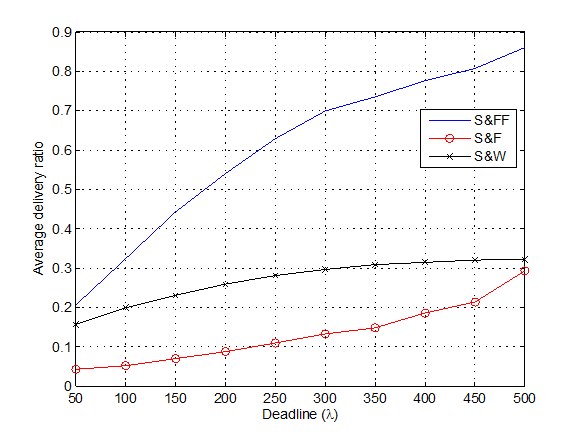Simulation-Based Performance Comparison for Variants of Spray and Wait in Delay Tolerant Networks
Keywords:
Delay Tolerant Networks, Spray and Wait, Spray and Fuzzy Forwarding, Performance EvaluationAbstract
Delay Tolerant Network (DTN) has been proposed to deliver data packets in an intermittently connected network by the store and carry technique. Among many existing routing protocols in DTN, spray and wait and its variants are based on replication by allowing the number of copies per message in the network but they still include some problems. To address energy issue and delivery ratio, we have presented the spray and fuzzy forwarding (S&FF) to employ the fuzzy inference systems (FIS). However, since our previous performance comparisons are simply evaluated over few cases, more extensive simulation scenarios need to be executed for accurate performance comparison. Based on this demand, in this paper, we compare S&FF with some variants of spray and wait in diverse aspects and provide analysis for their simulation results. Through the simulation results, we can observe that delivery ratio is acceptable while extending network lifetime in S&FF rather than comparable protocols under varying deadlines, the number of nodes and velocities.
References
M. Khabbaz, C. Assi, and W. Fawaz, “Disruption-tolerant networking: A comprehensive survey on recent developments and persisting challenges,” IEEE Communications Surveys & Tutorials, vol. 14, no. 2, pp. 607-640, 2012.
J. Mukherjee and B. Ramamurthy, “Communication technologies and architectures for space network and interplanetary internet,” IEEE Communications Surveys & Tutorials, vol. 15, no. 2, pp. 881-897, 2013.
N. Benamara, K. D. Singhb, M. Benamara, D. Ouadghiria, and J. Bonninb, “Routing protocols in vehicular delay tolerant networks: A comprehensive survey,” Computer Communications, vol. 48, no. 15, pp. 141-158, 2014.
A. Vahdat and D. Becker, “Epidemic routing for partially connected ad hoc networks,” Technical Report CS-200006, Duke University, 2000.
A. Lindgren, A. Doria, and O. Schelen, “Probabilistic routing in intermittently connected networks,” ACM SIGMOBILE Mobile Computing and Communications Review, vol. 7, no. 3, pp. 19-20, 2003.
A. Balasubramanian, B. N. Levine, and A. Venkataramani, “Replication routing in DTNs: A resource allocation approach,” IEEE/ACM Transactions on Networking, vol. 18, no. 2, pp. 596-609, 2010.
T. Spyropoulos, K. Psounis, and C. S. Raghavendra, “Spray and wait: An efficient routing scheme for intermittently connected mobile networks,” Proc. ACM SIGCOMM workshop on Delay-tolerant networking, Philadelphia, PA, USA, August 2005, pp. 252-259.
T. Spyropoulos, K. Psounis, and C. S. Raghavendra, “Spray and focus: efficient mobility-assisted routing for heterogeneous and correlated mobility,” Proc. the Fifth Annual IEEE International Conf. Pervasive Computing and Communications Workshops (PerComW’07), New York, USA, March 2007, pp. 452-456.
M. A. Azim, B. S. Kim, K. H. Kim and K. I. Kim, “Spray and fuzzy based forwarding in delay tolerant networks,” under review in IEICE Transactions on Communications.
M. Liu, Y. Yang, and Z. Qin, “A survey of routing protocols and simulations in delay-tolerant networks,” Int. Conf. Wireless Algorithms, Systems, and Applications, vol. 6843, pp. 243-253, 2011.
Agussalim and M. Tsuru, “Comparison of DTN routing protocols in realistic scenarios,” Int. Conf. Intelligent Networking and Collaborative Systems, IEEE press, September 2014, pp. 400-405.
A. Nguyen and P. Sénac and V. Ramiro and M. Diaz, “STEPS-an approach for human mobility modeling,” Proc. the 10th international IFIP TC 6 conf. Networking, pp. 254-265, May 2011.
A. Mathurapoj, C. Pornavalai, and G. Chakraborty, “Fuzzy-spray: efficient routing in delay tolerant ad-hoc network based on fuzzy decision mechanism,” Proc. IEEE Int’l Conf. Fuzzy Systems, IEEE press, August 2009, pp. 104-109.
M. H. Mamoun and S. Barrak, “Adaptive priority routing protocol for DTN networks,” International Journal of Engineering and Technology, vol. 3, no. 3, pp. 258-264, 2013.
J. Makhlouta, H. Harkous, F. Hutayt, and H. Artail, “Adaptive fuzzy spray and wait: efficient routing for opportunistic networks,” Proc. IEEE Int. Conf. Selected Topics in Mobile and Wireless Networking (iCOST), IEEE press, October 2011, pp. 64-69.
E. M. Sammou, “Spray and dynamic: advanced routing in delay tolerant networks,” Int. J. Communications, Network and System Sciences, pp. 98-104, 2012.
J. Burgess, B. Gallagher, D. Jensen, and B. N. Levine, “Maxprop: routing for vehicle-based disruption-tolerant networks,” Proc. 25th IEEE Int. Conf. Computer Communications (INFOCOM), IEEE press, April 2006.
K. Fall, W. Hong, and S. Madden, “Custody transfer for reliable delivery in delay tolerant networks,” Intel Research Berkeley, Technical Report IRB-TR-03-030, 2003.
S. L. F. Maia, E. R. Silva, and P. R. Guardieiro, “A new optimization strategy proposal for multi-copy forwarding in energy constrained DTNs,” IEEE Communications letters, vol. 18, no. 9, pp. 1623-1626, 2014.
M. N. Sadat and S. A. M. T Mohiuddin, “Delivery likelihood based spraying in delay tolerant networks,” Int. Conf. Electrical Engineering and Information & Communication Technology (ICEEICT), IEEE press, April 2014.
S. Jain, K. Fall, and R. Patra, “Routing in a delay tolerant network,” Proc. the 2004 conf. Applications, technologies, architectures, and protocols for computer communications, September 2004, pp. 145-158.
E. Bulut, Z. Wang, and B. Szymanski, “Time dependent message spraying for routing in intermittently connected networks,” Global Telecommunications Conference (IEEE GLOBECOM ’08), IEEE press, December 2008.
E. Bulut, Z. Wang, and B. Szymanski, “Cost-effective multiperiod spraying for routing in delay-tolerant networks,” IEEE/ACM Transactions on Networking, vol. 18, no. 5, pp. 1530-1543, 2010.

Published
How to Cite
Issue
Section
License
Copyright (c) 2017 International Journal of Engineering and Technology Innovation

This work is licensed under a Creative Commons Attribution-NonCommercial 4.0 International License.
Copyright Notice
Submission of a manuscript implies: that the work described has not been published before that it is not under consideration for publication elsewhere; that if and when the manuscript is accepted for publication. Authors can retain copyright in their articles with no restrictions. Also, author can post the final, peer-reviewed manuscript version (postprint) to any repository or website.

Since Jan. 01, 2019, IJETI will publish new articles with Creative Commons Attribution Non-Commercial License, under Creative Commons Attribution Non-Commercial 4.0 International (CC BY-NC 4.0) License.
The Creative Commons Attribution Non-Commercial (CC-BY-NC) License permits use, distribution and reproduction in any medium, provided the original work is properly cited and is not used for commercial purposes.


.jpg)


